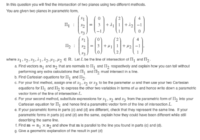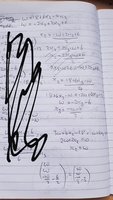You are using an out of date browser. It may not display this or other websites correctly.
You should upgrade or use an alternative browser.
You should upgrade or use an alternative browser.
Vectors: You are given two planes in parametric form....
- Thread starter GetReal
- Start date
HallsofIvy
Elite Member
- Joined
- Jan 27, 2012
- Messages
- 7,763
You have two planes given by
\(\displaystyle \Pi_1:\begin{bmatrix}x_1 \\ x_2 \\ x_3 \end{bmatrix}= \begin{bmatrix}0 \\ 3 \\ -1 \end{bmatrix}+\lambda_1 \begin{bmatrix} 2 \\ 1 \\ 1 \end{bmatrix}+ \lambda_2\begin{bmatrix}4 \\ -1 \\ 0 \end{bmatrix}\) and
\(\displaystyle \Pi_2:\begin{bmatrix}x_1 \\ x_2 \\ x_3 \end{bmatrix}= \begin{bmatrix}0 \\ 3 \\ 0 \end{bmatrix}+\mu_1 \begin{bmatrix} 2 \\ 1 \\ 2 \end{bmatrix}+ \mu_2\begin{bmatrix}4 \\ -1 \\ 1 \end{bmatrix}\)
\(\displaystyle \Pi_1:\begin{bmatrix}x_1 \\ x_2 \\ x_3 \end{bmatrix}= \begin{bmatrix}0 \\ 3 \\ -1 \end{bmatrix}+\lambda_1 \begin{bmatrix} 2 \\ 1 \\ 1 \end{bmatrix}+ \lambda_2\begin{bmatrix}4 \\ -1 \\ 0 \end{bmatrix}\) and
\(\displaystyle \Pi_2:\begin{bmatrix}x_1 \\ x_2 \\ x_3 \end{bmatrix}= \begin{bmatrix}0 \\ 3 \\ 0 \end{bmatrix}+\mu_1 \begin{bmatrix} 2 \\ 1 \\ 2 \end{bmatrix}+ \mu_2\begin{bmatrix}4 \\ -1 \\ 1 \end{bmatrix}\)
pka
Elite Member
- Joined
- Jan 29, 2005
- Messages
- 11,971
To GetReal, I say get real yourself. Please learn to post readable questions. It is only thanks to Prof. Ivy that I have any idea what you are asking.
In the post \(\displaystyle \vec{p}+\lambda_1\vec{u}+\lambda_2\vec{v}\) is a plane that contains the point \(\displaystyle p\) and is spanned be \(\displaystyle \vec{u}~\&~\vec{v}\).
Sadly I tell you that notation is arcane at best. Almost all modern textbooks would give the same plane as;
\(\displaystyle {<x,y,z>}\cdot(\vec{u}\times\vec{v})=\vec{p}\cdot(\vec{u}\times\vec{v}) \)
In the post \(\displaystyle \vec{p}+\lambda_1\vec{u}+\lambda_2\vec{v}\) is a plane that contains the point \(\displaystyle p\) and is spanned be \(\displaystyle \vec{u}~\&~\vec{v}\).
Sadly I tell you that notation is arcane at best. Almost all modern textbooks would give the same plane as;
\(\displaystyle {<x,y,z>}\cdot(\vec{u}\times\vec{v})=\vec{p}\cdot(\vec{u}\times\vec{v}) \)


